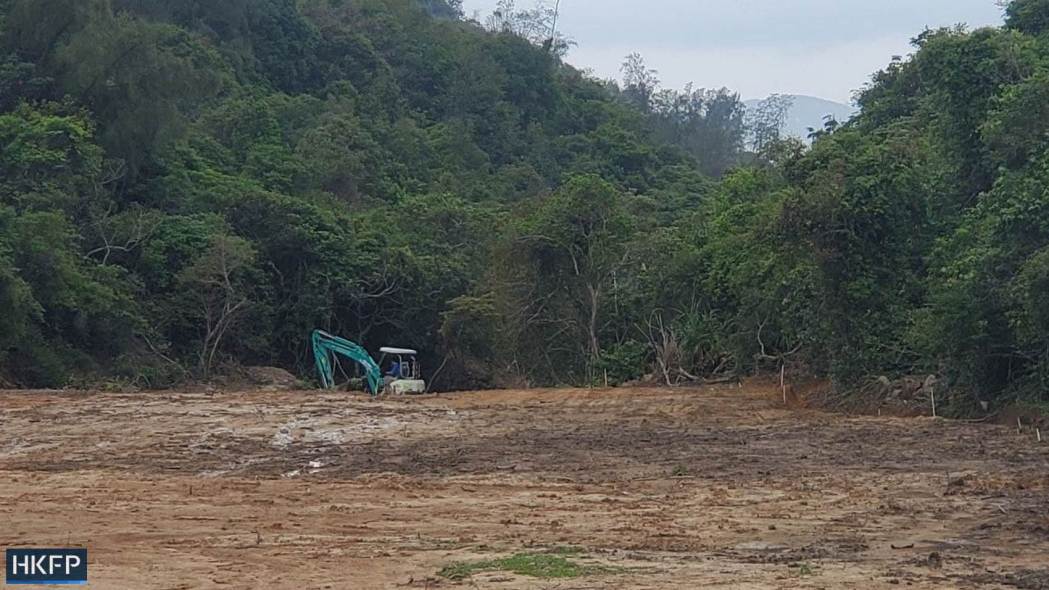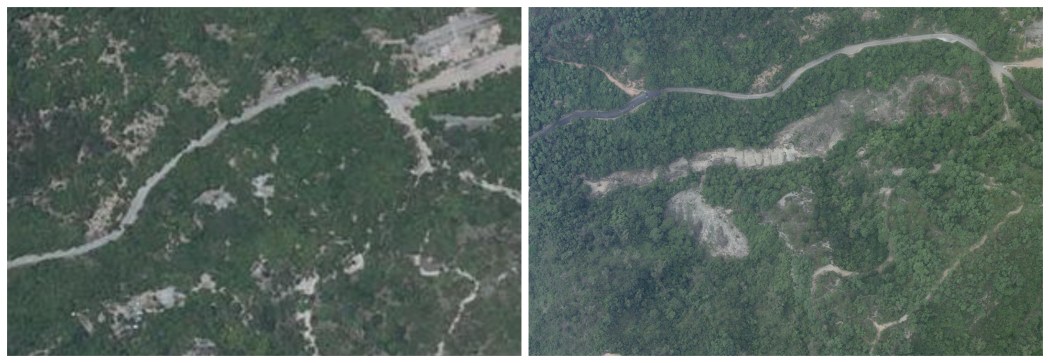The government has handed down a HK$500 fine after trees were illegally removed next to an expansive private plot in a Hong Kong country park. The penalty came 16 months after villagers and activists first reported land clearing activities to the authorities.

In January 2020, villagers living near Pui O and conservation activists saw construction vehicles removing trees to flatten a vast area next to the entrance of Chi Ma Wan Country Trail, within the Lantau South Country Park.
The area consisting of nine disjointed private lots, covers 10,000 square metres, roughly equal to the size of two American football fields.
They began a letter-writing campaign to the Lands Department (LD), Environmental Protection Department (EPD), and Agricultural, Fisheries and Conservation Department (AFCD) to report that a large amount of trees had been removed from what they thought was protected land.
In response, the EPD referred all complaints to the AFCD, the agency charged with enforcing Hong Kong’s Country Park Ordinance, while the LD told complainants that their inquiry would be followed up by their district office.

The AFCD said it received most of the complaints in May. Its responses to dozens of complainants noted that they were aware of the issue since as early as December 2019. Tree clearances on privately-owned land in country parks are not illegal, the department said, although their site inspection showed the clearance appeared to have infringed on government land that belongs to the country park.
“The affected area will be reinstated by planting of native shrubs,” one reply read.

Under the Country Park Ordinance, cutting any tree or digging soil in a country park without prior permission carry a maximum penalty of a HK$2,000 fine and imprisonment for three months upon conviction, but private land is exempt.
Hong Kong has about 460 hectares of private land situated within country parks, according to a 2011 document from the Country and Marine Parks Board.
“The area had been a jungle for the past several decades,” a villager living nearby, who asked not to be named for fear of retribution, told HKFP. “Look at what they’ve done to the land on Lantau.”

During HKFP’s visit last month, a lone green excavator was whirring away on one end of the plot. Lying in a shallow valley below a paved driveway, the land is accessible from the bare slope after vegetation surrounding its metal fencing — which demarcates the boundaries of private land – was removed.
Muddy puddles remained after days of rain, and a soaked government sign erected nearby warns that anyone who brings vehicles into a country park without authorisation or removes vegetation from its land may be prosecuted.

In response to an inquiry from HKFP, AFCD said it found “extension of works onto a small piece of government land adjacent to the private land and Chi Ma Wan Road in October 2020.”
HK$500 fine
“After investigation, the AFCD instituted prosecution by way of laying summons against the responsible person for disturbing soil in Lantau South Country Park without permission in April,” their statement read.
The defendant was convicted and fined HK$500 by the court on June 2.

Save Lantau Alliance’s Eddie Tse said it was “unbelievable” that such as large area was cleared out from a country park.
“This is completely ridiculous and has no deterrent effect,” Tse said. “This may even encourage people to think they could settle it by paying HK$500.”
Developers will typically accumulate agricultural land in their inventory as they wait to move in tandem with development plans the government might roll out in the future. Meanwhile they would use the land to run camp sites or for agricultural tourism, which are less profitable, Tse said.
Facilitating vehicle access
While the area used be part of the lush landscape between Pui O and Shap Long village, large-scale clearing began in as early as mid 2020: government satellite imagery from July last year shows that vegetation in the whole area was completely removed by then — including on government land squeezed between the disjointed lots — to form one unified strip.
It frustrated residents even further, when government workers from the Home Affairs Department turned up in the area in February to remove a cement barrier from a vehicle passing place. Without the barrier, construction vehicles and excavators were able to easily access the land.
The removal was done in response to the landowner’s request in late 2020, “on the grounds that the barrier was causing obstruction to the access to his property,” the department said in a statement to HKFP.

The private lots do not connect to the paved Chi Ma Wan Road. Metal fencing that appear to demarcate boundaries of the property is erected several meters off from the road, with government country park land encircling the property.
The AFCD, however, said a construction vehicle was brought in via access outside country park and did not violate the law.
The landlord also applied for water supply to the plot but the request was struck down by the Water Supplies Department after he failed to submit documents.

Similar to most other agricultural land in the New Territories, the area in Chi Ma Wan consists of “old schedule agricultural lots,” granted as part of a Block Crown Lease from the government in 1905. Hong Kong laws forbid the construction of structures without government approval on such old lots, but do not restrict how they could be used.
Inherited land
Bought in 1982 for a total of over HK$1.8 million, the nine lots are owned by a car racing instructor Shu Lui-yip, his mother and his sister through a company called Kam Har Limited, inherited as part of Shu’s father’s estate.
The Shus are not indigenous to nearby villages, as their father was a businessman in pharmaceuticals from Taiwan, who acquired land in Lantau in the 1980s, the villager told HKFP.
Another company from the estate, Priscilla Investments Limited, owned swathes of other land elsewhere in Lantau, according to court documents involving a dispute over the Shus’ estate. They included a smaller area on the hills of Lo Uk Tsuen behind Pui O, and several plots in the heart of the picturesque traditional fishing village Tai O, as well as properties elsewhere in Hong Kong.
Shu did not respond to requests for comments from HKFP. A woman who received HKFP’s letter containing questions for Shu at a residential address said he was out of town.

Tse, of the Save Lantau Alliance, questioned whether penalties specified in laws regulating the city’s country parks are too out-of-date as they were enacted in the 1970s.
“If our hands are completely tied in the face of development inside country parks — which are supposed to have higher protection status — then conservation of other less protected areas is simply much harder.”
Support HKFP | Policies & Ethics | Error/typo? | Contact Us | Newsletter | Transparency & Annual Report | Apps
Help safeguard press freedom & keep HKFP free for all readers by supporting our team

LATEST FROM HKFP
HKFP has an impartial stance, transparent funding, and balanced coverage guided by an Ethics Code and Corrections Policy.
Support press freedom & help us surpass 1,000 monthly Patrons: 100% independent, governed by an ethics code & not-for-profit.










